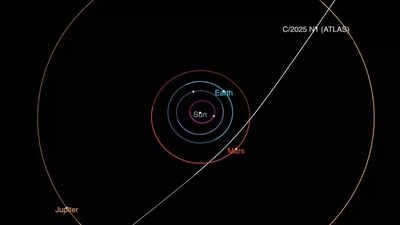NASA confirms 3I/ATLAS as third interstellar object passing through our solar system |

A mysterious object speeding through our solar system has officially been confirmed by NASA as an interstellar visitor — only the third of its kind ever recorded. The object, initially labelled A11pl3Z, has now been renamed 3I/ATLAS, with “3I” denoting its status as the third interstellar object detected.The discovery was made in late June 2025 by the Asteroid Terrestrial-impact Last Alert System (ATLAS), a NASA-funded network of telescopes scanning the skies from Hawaii, Chile, and South Africa. According to NASA’s ATLAS project, the object was captured in data collected between June 25 and 29, with earlier sightings traced back to June 14.On July 1, both NASA and the International Astronomical Union (IAU) confirmed its interstellar status based on its speed, orbit, and trajectory—characteristics that make it distinctly not bound by the Sun’s gravity.
Meet third known interstellar visitor after ʻOumuamua and 2I/Borisov
3I/ATLAS is hurtling toward the Sun at an incredible speed of 152,000 miles per hour (245,000 km/h)—far faster than most objects orbiting within our solar system, according to reports. What makes this object truly remarkable, however, is its hyperbolic trajectory. Unlike typical comets or asteroids that follow elliptical paths around the Sun, a hyperbolic orbit means 3I/ATLAS isn’t gravitationally bound to our star. Instead, it’s passing through from deep space—entering the solar system once, then heading back out forever. In other words, this rare visitor is just making a brief stop in our cosmic neighbourhood before continuing its journey across the galaxy.According to planetary scientist Sarah Greenstreet of the University of Washington, “Its orbit is too steep, and its speed is too great for it to be a solar system object”Only two other interstellar objects have ever been confirmed:
- ʻOumuamua in 2017—a cigar- or pancake-shaped object that left astronomers baffled.
- 2I/Borisov in 2019—a
comet with more conventional behaviour.
With just three known samples, studying 3I/ATLAS gives researchers an unprecedented chance to better understand the nature of objects from beyond our solar system.
Astronomers race to study 3I/ATLAS before it leaves forever
Astronomers are now racing to collect data on the object using a global network of ground- and space-based telescopes. 3I/ATLAS is thought to have a coma—the glowing halo of gas typical of comets—indicating that it contains volatile ices now vaporising as it nears the Sun.A recent observation suggests the object may appear reddish, hinting at its ancient composition—likely formed from primordial matter in another star system billions of years ago.Estimates suggest the object could be anywhere from 6 to 15 miles long, significantly larger than its predecessors. Its closest approach will bring it within 18 million miles of Mars in early October 2025. Several orbiters around the Red Planet may get the chance to image the object up close. As 3I/ATLAS speeds toward the inner solar system, scientists expect its cometary tail to grow, offering stunning visuals and deeper insight into its composition. “We’ll have a few more months before it heads back out,” said Aster Taylor, an astrophysicist at the University of Michigan. “This is a rare chance to study a piece of another planetary system—up close and in real-time,” added Greenstreet.Also Read: The 10 most powerful telescopes on Earth and in space transforming modern astronomy





